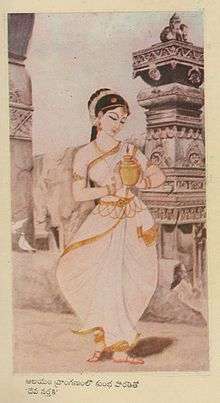Andhra Natyam
Andhra Natyam comprises Aagama Narthanam, Aasthana Narthanam and Prabhandha Narthanam. Andhra Natyam is performed by both men and women.
 Andhra Natyam illustration of a lady holding a kumbha harathi to worship God | |
| Genre | Indian Classical Dance |
|---|---|
| Origin | Andhra Pradesh, India |
Andhra Natyam is a classical dance form originating from the Indian states of Andhra Pradesh and Telangana. This traditional dance form, having a history of 2000 years, was lost in the Mughal and British era, and was revived in the 20th century.[1][2]
Introduction
This dance form is performed by both men and women, characterised by rich footwork and expressions (Abhinaya). The musical instruments accompanying the dance include mridangam, manjira, veena, the violin, venu, tanpura, surpeti and kanjira.[1]
Origin
It is derived from various dance forms including older dance styles like Dasiattam, Kacherittam and Chinnamelam. It has strong similarities with Bharatanatyam. Though it originated in temples, it was also performed by the courtesans known as kalavantulu in Telugu. Open-air public performances known as Kalapam (Navajanardhana parijatham) are a part of Andhra Natyam.[1]
See also
References
- Sinha, Aakriti (2006). Let's know dances of India. Star Publications.
- https://books.google.co.in/books?id=h67wZpGPUi0C&pg=PP19&dq=%22Andhra+Natyam%22&hl=en&sa=X&ved=0ahUKEwiItZ6aqtDnAhW973MBHcS3B5oQ6AEIKTAA#v=onepage&q=%22Andhra%20Natyam%22&f=false. Missing or empty
|title=(help)